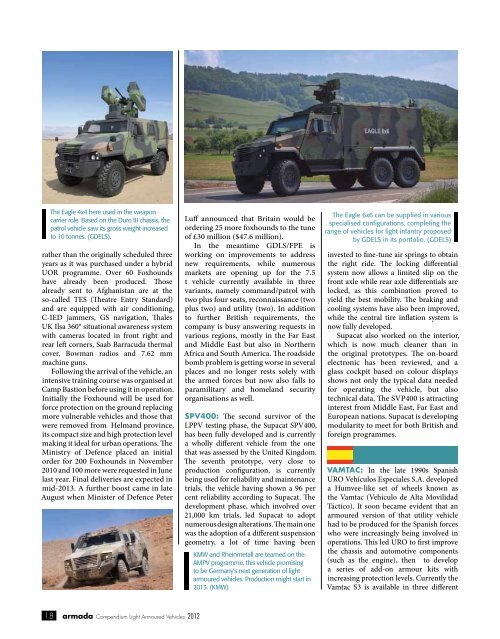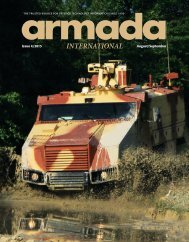Oct 2012 Compendium 1 - Armada
Oct 2012 Compendium 1 - Armada
Oct 2012 Compendium 1 - Armada
Create successful ePaper yourself
Turn your PDF publications into a flip-book with our unique Google optimized e-Paper software.
The Eagle 4x4 here used in the weapon<br />
carrier role. Based on the Duro III chassis, the<br />
patrol vehicle saw its gross weight increased<br />
to 10 tonnes. (GDELS).<br />
rather than the originally scheduled three<br />
years as it was purchased under a hybrid<br />
UOR programme. Over 60 Foxhounds<br />
have already been produced. Those<br />
already sent to Afghanistan are at the<br />
so-called TES (Theatre Entry Standard)<br />
and are equipped with air conditioning,<br />
C-IED jammers, GS navigation, Thales<br />
UK Ilsa 360° situational awareness system<br />
with cameras located in front right and<br />
rear left corners, Saab Barracuda thermal<br />
cover, Bowman radios and 7.62 mm<br />
machine guns.<br />
Following the arrival of the vehicle, an<br />
intensive training course was organised at<br />
Camp Bastion before using it in operation.<br />
Initially the Foxhound will be used for<br />
force protection on the ground replacing<br />
more vulnerable vehicles and those that<br />
were removed from Helmand province,<br />
its compact size and high protection level<br />
making it ideal for urban operations. The<br />
Ministry of Defence placed an initial<br />
order for 200 Foxhounds in November<br />
2010 and 100 more were requested in June<br />
last year. Final deliveries are expected in<br />
mid-2013. A further boost came in late<br />
August when Minister of Defence Peter<br />
18 armada <strong>Compendium</strong> Light Armoured Vehicles <strong>2012</strong><br />
Luff announced that Britain would be<br />
ordering 25 more foxhounds to the tune<br />
of £30 million ($47.6 million).<br />
In the meantime GDLS/FPE is<br />
working on improvements to address<br />
new requirements, while numerous<br />
markets are opening up for the 7.5<br />
t vehicle currently available in three<br />
variants, namely command/patrol with<br />
two plus four seats, reconnaissance (two<br />
plus two) and utility (two). In addition<br />
to further British requirements, the<br />
company is busy answering requests in<br />
various regions, mostly in the Far East<br />
and Middle East but also in Northern<br />
Africa and South America. The roadside<br />
bomb problem is getting worse in several<br />
places and no longer rests solely with<br />
the armed forces but now also falls to<br />
paramilitary and homeland security<br />
organisations as well.<br />
SpV400: The second survivor of the<br />
LPPV testing phase, the Supacat SPV400,<br />
has been fully developed and is currently<br />
a wholly different vehicle from the one<br />
that was assessed by the United Kingdom.<br />
The seventh prototype, very close to<br />
production configuration, is currently<br />
being used for reliability and maintenance<br />
trials, the vehicle having shown a 96 per<br />
cent reliability according to Supacat. The<br />
development phase, which involved over<br />
21,000 km trials, led Supacat to adopt<br />
numerous design alterations. The main one<br />
was the adoption of a different suspension<br />
geometry, a lot of time having been<br />
KMW and Rheinmetall are teamed on the<br />
AMPV programme, this vehicle promising<br />
to be Germany’s next generation of light<br />
armoured vehicles. Production might start in<br />
2013. (KMW)<br />
The Eagle 6x6 can be supplied in various<br />
specialised configurations, completing the<br />
range of vehicles for light infantry proposed<br />
by GDELS in its portfolio. (GDELS)<br />
invested to fine-tune air springs to obtain<br />
the right ride. The locking differential<br />
system now allows a limited slip on the<br />
front axle while rear axle differentials are<br />
locked, as this combination proved to<br />
yield the best mobility. The braking and<br />
cooling systems have also been improved,<br />
while the central tire inflation system is<br />
now fully developed.<br />
Supacat also worked on the interior,<br />
which is now much cleaner than in<br />
the original prototypes. The on-board<br />
electronic has been reviewed, and a<br />
glass cockpit based on colour displays<br />
shows not only the typical data needed<br />
for operating the vehicle, but also<br />
technical data. The SVP400 is attracting<br />
interest from Middle East, Far East and<br />
European nations. Supacat is developing<br />
modularity to meet for both British and<br />
foreign programmes.<br />
VAMTAc: In the late 1990s Spanish<br />
URO Vehículos Especiales S.A. developed<br />
a Humvee-like set of wheels known as<br />
the Vamtac (Vehículo de Alta Movilidad<br />
Táctico). It soon became evident that an<br />
armoured version of that utility vehicle<br />
had to be produced for the Spanish forces<br />
who were increasingly being involved in<br />
operations. This led URO to first improve<br />
the chassis and automotive components<br />
(such as the engine), then to develop<br />
a series of add-on armour kits with<br />
increasing protection levels. Currently the<br />
Vamtac S3 is available in three different



